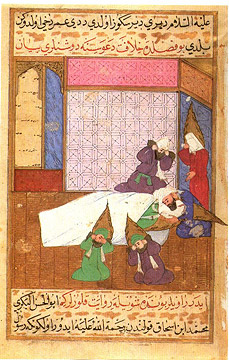Image Resource Bank
Image Gallery |  9 of 15
9 of 15 
Mourning the Prophet Muhammad’s Death, 632 CE.
This image, also from the sixteenth-century illustrated version of the Siyer-i Nebi, shows the mourning of the death of the Prophet Muhammad. According to Sunnī tradition, the Prophet died without naming a successor, and his death plunged the Muslim community into crisis. In Muhammad’s absence, who would lead the ummah, and, without recourse to prophethood, on what grounds would he legitimate his authority? Furthermore, was leadership to stay within the family of the Prophet or fall to someone else outside the Banū Hāshim? The political improvisation of a few of the Prophet’s closest companions established the office of caliph-imām, which briefly resolved the problem of succession by relocating the source of legitimacy within the consensus of the Muslim community. In the foreground of this painting are the Prophet’s grandsons, Hassan and Husayn, each despairing over the loss of their grandfather. While Hassan would go on to lead a relatively quiet and comfortable life in Medina, his younger brother, Husayn, would die leading a revolt in 680 CE aimed at dethroning the Umayyad caliph-imām and returning the leadership of the ummah to the Prophet’s family. Husayn’s death would later be recognized as a defining event in the elaboration of Shī‘ī Islam.
![]() Muhammad Designating ‘Ali His First Successor at Ghadīr Khum
Muhammad Designating ‘Ali His First Successor at Ghadīr Khum
Name: Mourning the Prophet Muhammad’s Death, 632 CE.
Material: JPEG Image (original: gouache on paper)
Size: 640 x 1005 pixels
Date: late 16th century
Place of Origin: Ottoman Empire, Western Anatolia
Location: Topkapı Museum, Istanbul
Source and Registration#: Professor John E. Woods

 John Woods
John Woods
Professor of Iranian and Central Asian History, and of Near Eastern Languages & Civilizations
 Alexander Barna
Alexander Barna
Outreach Coordinator, Center for Middle Eastern Studies, University of Chicago




